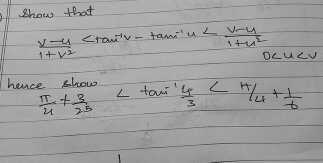Problem:
http://9gag.com/gag/aVDxn1O
Solution:
Denote bottle by $ b $
$ b + b + b = 30 $, therefore $ b = 10 $.
Denote the hamburger by $ h $
$ b + h + h = 20 $, therefore $ h = 5 $
Denote the beer by $ e $
$ h + e + e = 9 $, therefore $ e = 2 $.
Now here is the fun
$ \int\limits_{2h - b}^{\infty}{\frac{b\sin x}{ex}dx} = \int\limits_{0}^{\infty}{\frac{10\sin x}{2x}dx} = 5\int\limits_{0}^{\infty}{\frac{\sin x}{x}dx} = \frac{5\pi}{2} $
The last integral is well known, for example, see:
http://math.stackexchange.com/questions/5248/solving-the-integral-int-0-infty-frac-sinxx-dx-frac-pi2
This video explains the Feynman trick!
https://www.youtube.com/watch?v=3LsXWPzlOhQ
Have fun!
Solution:
Denote bottle by $ b $
$ b + b + b = 30 $, therefore $ b = 10 $.
Denote the hamburger by $ h $
$ b + h + h = 20 $, therefore $ h = 5 $
Denote the beer by $ e $
$ h + e + e = 9 $, therefore $ e = 2 $.
Now here is the fun
$ \int\limits_{2h - b}^{\infty}{\frac{b\sin x}{ex}dx} = \int\limits_{0}^{\infty}{\frac{10\sin x}{2x}dx} = 5\int\limits_{0}^{\infty}{\frac{\sin x}{x}dx} = \frac{5\pi}{2} $
The last integral is well known, for example, see:
http://math.stackexchange.com/questions/5248/solving-the-integral-int-0-infty-frac-sinxx-dx-frac-pi2
This video explains the Feynman trick!
https://www.youtube.com/watch?v=3LsXWPzlOhQ
Have fun!

